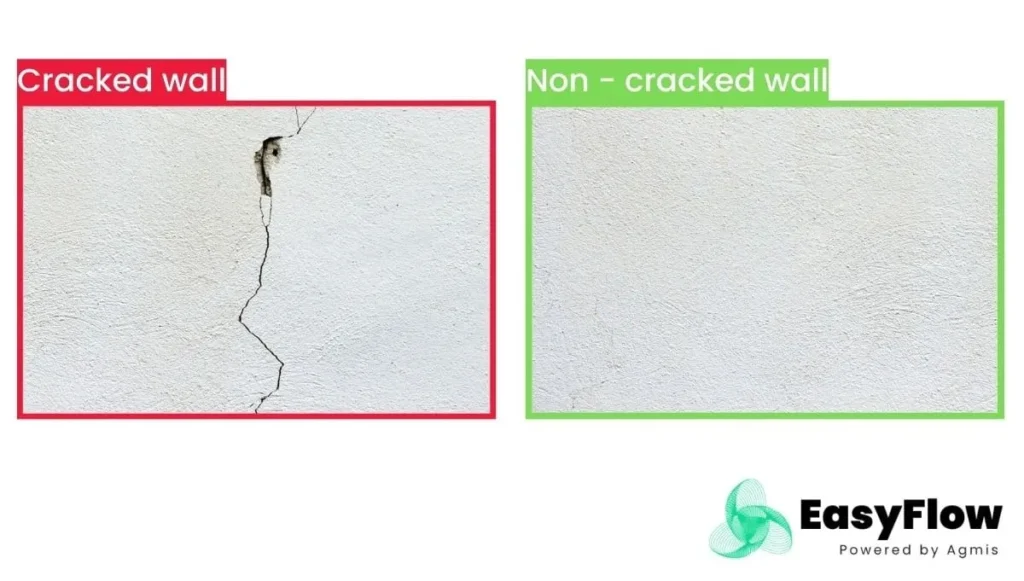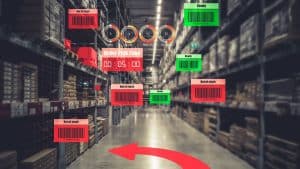Computer vision in construction offers a wide range of applications that streamline equipment management, improve maintenance practices, and enable real-time asset tracking. AI is utilized in quality control to identify irregularities, ensure standards compliance, and enhance overall results.
Navigation is made more efficient with detailed mapping and precise location tracking for safety monitoring and risk assessment. Automated hazard detection helps manage construction zones effectively. Logistics optimization and productivity enhancement are achieved through improved material and workforce management.
Detecting structural defects ensures compliance with safety regulations. These applications showcase the transformative impact of computer vision on construction processes and outcomes.
Want to transfer your construction site into the feature? Take a look to our computer vision consulting services.
Equipment Tracking and Management
Efficient tracking and management of construction equipment are essential for ensuring optimal utilization, maintenance, and safety compliance within construction projects. By employing equipment utilization analysis and predictive maintenance strategies, construction companies can enhance machinery usage efficiency while minimizing downtime.
Real-time equipment location tracking, combined with predictive analytics, enables proactive maintenance scheduling, reducing the likelihood of unexpected breakdowns and ensuring seamless project operations.
Through the implementation of these advanced tracking and management techniques, construction firms can streamline processes, optimize resource allocation, and improve overall project performance. Proactive maintenance based on predictive analytics not only extends equipment lifespan but also fosters a safer working environment by reducing the risk of accidents caused by equipment failures.
Asset Management and Maintenance
Utilizing advanced asset tracking technologies and maintenance strategies is crucial to ensure the longevity, efficiency, and safety compliance of construction assets in project environments.
Maintenance scheduling is pivotal in preventing unexpected breakdowns, optimizing asset utilization, and reducing operational downtime.
By monitoring the condition of construction assets, companies can enhance asset lifespan, minimize waste, and ensure compliance with safety standards and regulations.
Implementing proactive maintenance measures based on data analytics and predictive maintenance can help identify potential issues before they escalate, thereby enhancing overall asset performance and longevity.
Effective asset management and maintenance not only enhance operational efficiency but also play a vital role in cost reduction and ensuring the safety of construction personnel and site visitors.
Automated Quality Control
Automated quality control in construction utilizes camera sensors and AI technology to accurately identify irregularities in materials. This process is crucial for ensuring quality assurance by detecting defects early on, thus preventing rework and safety risks.
Through continuous monitoring of materials and construction processes, automated quality control helps enhance product quality, save time, and reduce costs by detecting errors promptly. It improves the construction industry’s ability to uphold high standards, meet project requirements, and comply with safety regulations, leading to optimized construction outcomes and client satisfaction.
Hazardous Materials Detection
The progress of computer vision technology in construction extends to the crucial area of detecting and identifying hazardous materials on-site. By recognizing signs of dangerous goods and accurately identifying hazardous materials, computer vision plays a vital role in enhancing safety protocols and optimizing control measures in construction environments.
This technology helps in reinforcing compliance with safety regulations and protocols, ensuring that workers are promptly alerted to potential risks. By incorporating computer vision for hazardous materials detection, construction sites can proactively handle safety-related tasks and mitigate potential hazards more effectively.
Ultimately, this application of computer vision contributes to a safer working environment by streamlining safety procedures and protocols.
Automated Inspection and Safety


In the realm of construction technology, computer vision revolutionizes the inspection and safety processes with advanced AI vision capabilities. Automated safety protocols bolster workplace security by employing AI-powered hazard detection systems. These systems can automatically recognize Personal Protective Equipment (PPE detection) and potential safety hazards, eradicating the need for manual inspection and saving valuable time.
By integrating AI vision for automated inspection, construction sites can ensure consistent and unbiased safety assessments. This technology not only streamlines safety procedures but also fosters a proactive safety culture by promptly identifying and addressing potential risks.
Automated inspection and safety systems play a pivotal role in upholding a safe work environment, ultimately enhancing overall project efficiency and risk management. Read the pilot study we conducted within three major construction companies in Lithuania.
Process Optimization and Tracking
Enhancing construction project efficiency necessitates meticulous monitoring and optimization of processes to ensure timely and cost-effective completion. Optimization techniques are crucial for streamlining workflows and enhancing productivity in construction projects.
By integrating computer vision technologies for project tracking, construction teams can oversee progress, identify bottlenecks early, and make informed decisions to optimize processes. These strategies empower project managers to ensure tasks are completed punctually and within budgetary constraints.
Efficient utilization of project tracking tools facilitates resource and task management, resulting in enhanced project outcomes. By continuously monitoring and adjusting processes based on tracked data, construction projects can be executed more efficiently and with greater precision.
Analog Dial Reading With AI Vision
Employing AI vision technology for interpreting analog dials revolutionizes data analysis and decision-making in construction projects. By utilizing IoT scale applications, real-time digitization of indicators is facilitated, offering immediate and precise information for project oversight.
This technology enhances worker safety by minimizing their exposure to potentially hazardous manual reading tasks. Through the incorporation of real-time analytics, construction teams can swiftly make well-informed decisions, optimizing processes and enhancing overall project efficiency.
The capability to interpret analog dials with image recognition not only streamlines operations but also ensures data digitization for improved analysis and forecasting. In summary, the integration of AI vision technology in analog dial reading modernizes traditional practices, fostering a safer and more efficient construction environment.
Measurement and Estimation
Computer vision technology offers precise and accurate measurements for the construction industry, assisting in project planning and execution. By utilizing computer vision estimation techniques and sophisticated measurement algorithms, distances, angles, and dimensions can be estimated with precision.
These tools also streamline the process of measuring construction material volumes. Incorporating computer vision for measurements and estimations enhances the precision of project planning and execution, leading to improved project outcomes.
The use of advanced algorithms in computer vision ensures detailed and reliable measurements, enhancing decision-making processes in the construction sector.
Structural Defect Detection


Utilizing deep learning techniques is crucial in the field of structural defect detection to pinpoint and address risks related to infrastructure integrity. These advanced applications allow for the examination of intricate structural data to spot potential defects like cracks, leaks, or deformities.
By harnessing sophisticated algorithms, these systems can pinpoint irregularities that could jeopardize the safety and durability of buildings, bridges, or other structures. The integration of deep learning in defect detection improves risk management strategies by issuing early alerts, enabling proactive maintenance, and ensuring compliance with structural safety regulations.
This technology revolutionizes infrastructure inspection methods, offering a more efficient and precise approach to promptly identifying and resolving structural shortcomings.
3D Infrastructure Scanning
The utilization of computer vision technology expands to 3D infrastructure scanning, which helps in creating detailed as-built models and deepening comprehension of structural components through advanced point cloud algorithms.
3D modeling tools facilitate the production of accurate representations of existing structures, assisting in renovation and maintenance endeavors. Point cloud analysis enhances this procedure by transforming captured data into actionable insights, enabling precise measurements and evaluations.
This technology is widely used in architecture and engineering, offering a comprehensive perspective of infrastructure elements. By employing 3D modeling and point cloud analysis, construction professionals can streamline decision-making processes and ensure the effective execution of projects with enhanced precision and efficiency.
Mapping With Computer Vision
Computer vision technology has revolutionized navigation tasks across industries, offering enhanced capabilities for tracking individuals, objects, and surroundings.
AI-powered navigation systems utilize spatial recognition to develop detailed maps of indoor spaces, enabling precise location tracking and route planning. Through the use of image recognition algorithms, these systems can accurately identify and map out surroundings in real-time, facilitating seamless movement within intricate environments.
Furthermore, stereo reconstruction algorithms play a crucial role in creating 3D models from captured images, enhancing the comprehension of spatial relationships. This advanced mapping technology not only boosts navigation accuracy but also paves the way for automated guidance systems and improved decision-making processes based on real-world spatial data.
Safety Monitoring and Security
Computer vision technology plays a crucial role in enhancing safety monitoring and security measures in construction environments by enabling real-time monitoring and detection of potential hazards. By implementing security protocols and anomaly detection, construction sites can proactively identify safety risks and unauthorized activities.
Computer vision systems can monitor worker surroundings, detect unusual events, and enforce safety policies to improve overall security. These systems also act as a deterrent against crime and vandalism, contributing to a safer work environment.
Through the use of advanced algorithms and real-time image analysis, computer vision enhances safety and security on construction sites, ensuring compliance with regulations and minimizing risks to personnel and assets.
Construction Zone Detection
Enhancing safety and efficiency on construction sites is crucial through the automated detection and classification of designated construction zones using computer vision technology. This process involves identifying hazard zones and effectively monitoring construction sites.
By dividing sites into virtual areas to track hazards, this technology boosts safety and security within construction zones. Detecting hazard zones is vital for preemptive safety measures, safeguarding workers and assets.
Moreover, monitoring construction sites enables proactive risk management, leading to streamlined workflows and enhanced operational efficiency. Computer vision’s precise identification and classification of construction zones play a key role in mitigating hazards and ensuring a secure environment on construction sites.
Material Management With AI
The effective handling of construction materials with AI technology plays a vital role in optimizing logistics, cutting costs, and enhancing operational efficiency in construction projects.
AI-powered material management systems can identify and categorize different building materials, making inventory tracking more precise. By utilizing optimization techniques like demand prediction and real-time monitoring, construction firms can streamline their supply chain processes and reduce wastage.
These systems not only improve inventory control but also aid in efficient resource distribution and timely material delivery to construction sites. By integrating AI into material management, construction projects can achieve substantial enhancements in productivity and cost-effectiveness while ensuring smooth operations.
Workforce Management
Efficiently managing the construction workforce is crucial for optimizing operational efficiency and ensuring project success through effective coordination of labor, equipment, and resources.
The utilization of computer vision technology for workforce management can significantly boost productivity and labor efficiency. By monitoring the movement of workers, vehicles, and equipment, construction managers can oversee construction quality and subcontractor services in real-time.
This streamlining of workflows allows for improved resource allocation, leading to enhanced project timelines and cost-effectiveness. Furthermore, computer vision assists in identifying potential bottlenecks or issues that may affect productivity, enabling prompt implementation of proactive solutions.
Conclusion
In conclusion, the integration of computer vision technology in construction has revolutionized project management and safety procedures.
The diverse uses of computer vision, including equipment monitoring, automated quality assurance, and identification of hazards, have significantly enhanced productivity and adherence to safety regulations.
As construction firms increasingly adopt machine learning algorithms and AI vision systems, the future prospects of computer vision in construction projects are optimistic, with continual progress in optimizing operations and enhancing project results.
Curious About The Above Solution?
Chat with Vejūnė and explore your possibilities without any commitment.


Vėjūnė Krašinskienė
Chief Operating Officer
Book a no-obligation free consultation with our expert.


